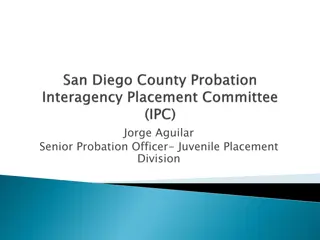Introduction to Care Assessment Tools (CATs) in Primary Care Placements
Care Assessment Tools (CATs) are becoming essential in primary care placements, offering a comprehensive way to record and assess performance against specific capabilities. This shift will require a minimum number of Case-based Discussions (CbDs) and CATs at various stages of training. The suggested CAT formats include Case-based Discussions, Random case reviews, Leadership activities, and more. Trainees will progress from CbDs in earlier stages to a wider range of CATs in later stages, ensuring a varied assessment approach across different settings to cover all capabilities and Clinical Experience Groups.
Download Presentation

Please find below an Image/Link to download the presentation.
The content on the website is provided AS IS for your information and personal use only. It may not be sold, licensed, or shared on other websites without obtaining consent from the author.If you encounter any issues during the download, it is possible that the publisher has removed the file from their server.
You are allowed to download the files provided on this website for personal or commercial use, subject to the condition that they are used lawfully. All files are the property of their respective owners.
The content on the website is provided AS IS for your information and personal use only. It may not be sold, licensed, or shared on other websites without obtaining consent from the author.
E N D
Presentation Transcript
Care Assessment Tool CAT Dr Chris Webb - December 2020
CbDs in General Practice / primary care placements are being replaced by Care Assessment Tools (CATs), which allows a greater range of information and performance to be recorded and assessed against the Capabilities. CbDs will remain in the non-primary care setting and become one type of CAT in the primary care setting
A minimum of 4 CbDs will be required for both ST1 and 2, and a minimum of 5 CATs (which can include CbDs) by the end of ST3
Suggested CAT formats Case-based Discussion (CbD) Random case review Leadership activities Prescribing assessment follow up Consultation assessments - which are not COTs Referrals review Other eg debrief, review of investigations or imaging use, follow up of QIP (please describe)
Range of CATs In ST1 and ST2 the trainee will only do CbDs as this is a tool that is already familiar in both primary and secondary care settings and it will ensure consistency In ST3, however, they can complete a range of different types of CAT depending on the clinical / educational setting. There are no set numbers for each different type of CAT
CATs and Capabilities Ideally the CATS will cover the full range of the capabilities. This will provide a triangulation of grades for each capability across of range of different assessment methods It is expected that the trainee will have been assessed in all of the capabilities using a formal assessment tool at least once in their training
CATs and Clinical Experience Groups While it is not mandatory for the trainee to have a CAT for each Clinical Experience Group, a range of types of assessment and information will need to be provided in the Portfolio to show exposure to, learning from, and competence in caring, for the range of Clinical Experience Groups across each training year
No. of Capabilities and Clinical Experience Groups linked to each CAT It is expected that a maximum of 3 capabilities and 2 Clinical Experience Groups be linked to each CAT so that in-depth reflection and meaningful feedback is given for each Separate assessments can be used if the assessment covers a larger number of either
Length of time needed to complete a CAT This will depend on the type of assessment being completed A referrals review may take a couple or hours A debrief may take 15 minutes and a CbD usually takes between 20- 30 minutes A random case review may take an hour but will depend on the number of consultations reviewed The time for each assessment will depend on the content and the discussion that takes place
Case based Discussion (CbD) (see separate presentation)
Preparation None
Content Supervisor guidance Select a date and surgery at random from the trainee s appointment list and access the patient records There are many different ways to review random cases. Reviewing consecutive patients can be helpful and reviewing a whole surgery will give a picture of overall performance It can also be useful to review a random surgery looking through one particular lens e.g. the appropriateness of the diagnosis or decision making; or understanding of the home circumstances of each patient / their support systems etc. i.e. how well the trainee assessed them holistically; or considering examinations carried out in detail; or recording (use of coding); or completion of all possible pop up tasks
Content ....Continued Alternatively, it can be appropriate to look at only 1-2 cases chosen by the supervisor and review multiple Capabilities in more detail in these cases Review how long the consultation took, as well as their recording of the consultation itself. These can be used to assess organisation, management and leadership Review the trainee s recording, using READ/ SNOMED codes as appropriate, observations recorded, history and other data gathering as well as clinical management, diagnosis and decisions and follow up
Content ...Continued Involvement of other doctors or team members may also be reviewed which can give information for the Capability of working with colleagues and teams How much health promotion was undertaken? Holistic care and managing medical complexity Did the trainee see a range of patient types, conditions and mix of urgent and unscheduled care and routine appointments? Are there actions that need to be planned in response to the balance of their work across clinical experience groups and medical specialities?
Capability areas suggested All areas may be possible depending on the detail of recording
Recording in the Portfolio Supervisor guidance Pick the Capabilities demonstrated and give specific case detail to justify the grading given, relating this to the Capability descriptors Give specific feedback for each Capability with agreed plans for each
Leadership activities (see separate presentation)
This is a follow up to the full prescribing assessment and should focus on the areas for development detailed in the prescribing assessment and how the trainee has progressed with these. This may involve finding and analysing prescriptions done for specific Clinical Experience Groups, for example, children, end of life, controlled drugs use, advice re over the counter (OTC) medications, particular specialty drugs e.g. for COPD, or contraception
Preparation Trainee They review their prescribing assessment and agreed actions. In particular they need to ensure that any of the prescribing proficiencies which they did not cover in their assessment have now been met They need to upload any further results in the Portfolio learning log They need to reflect on their performance against the prescribing competences Their supervisor will review their evidence and discuss this with them
Preparation Trainer Review and discuss the trainee s further evidence in the Portfolio and evidence from random case reviews and debriefs Review the prescribing assessment action plan and PDP entry progress Discuss areas done well and areas for improvement Together agree plans for further improving the trainee s prescribing or increasing their exposure to patient groups to meet the prescribing competences Discuss how this has provided evidence for the prescribing competences as described in the feedback and recommendations Discuss hypothetical situations where issues have not been not covered such as prescribing unlicensed drugs, drug interactions, over the counter (OTC) medication, allergies and monitoring requirements
Capability areas suggested Clinical management. Has the trainee prescribed safely? Are they aware of and are they applying local and national guidelines including drug and non-drug therapies? Are they aware of legal frameworks for appropriate prescribing? Managing medical complexity. Has the trainee simultaneously managed patients health problems, both acute and chronic (e.g. by taking into account comorbidities, existing medication and allergies), communicated risk effectively to patients (from documentation in the clinical records), recognised the inevitable conflicts that arise when managing patients with multiple problems and taken steps to address these Organisation, management and leadership. Has the trainee produced records that are succinct, comprehensive, appropriately coded and understandable?
Community orientation. Has the trainee demonstrated how they have adapted their own clinical practice to take into account their local resources, for example colleagues with GPSPI experience; or in cost-effective prescribing by following local protocols? Maintaining performance Learning and teaching. Has the trainee shown a commitment to professional development through reflection on performance and the identification of personal learning needs? Fitness to practice. Has the trainee reflected on and learnt from performance issues (e.g. drug errors) in order to improve patient care?
Recording in the Portfolio The supervisor completes a prescribing assessment CAT detailing the Capabilities covered and record for each: Specific feedback on performance Recommendations for further development
Preparation Trainee They should gather together either a list of all their referrals or copies of the referral letters to review They should ensure sufficient time has elapsed to get letters back from the clinic visit following the patient appointment
Preparation Trainer Look through the letters the trainee has written encouraging the trainee to critique their work Discuss the content commenting on what is good and what could be improved Is there evidence in the referral letters of appropriate data gathering, clinical examinations and procedural skills, clinical management and diagnosis and decisions? Look at the correspondence received following the referral and subsequent GP consultations
Preparation ...Continued Comment on the quality of the trainee s records Discuss the appropriateness and effectiveness of the referral. What other options were available? What does the trainee feel, in retrospect, about each referral? What feedback would you give the trainee in general about their referrals?
Preparation ...Continued Were any 2 week wait referrals in line with current guidance? What percentage of 2 week wait referrals resulted in a diagnosis of cancer? Review the appropriateness in particular of these referrals checking for any delays but also commenting on examples of good patient care Has the referral review demonstrated that the trainee is being exposed to the full range of patients groups in general practice and a broad range of curriculum types? How might the trainee develop experience in populations or specialties in which there does not appear to have been sufficient exposure?
Capability areas suggested Select the Capability areas the trainee has demonstrated during this discussion Give feedback on what they did well and what they should work on to improve or demonstrate in future learning events
Recording in the Portfolio Supervisor guidance Describe for each Capability how the trainee performed using the Capability descriptors and specific aspects of the cases discussed Describe the agreed actions discussed























